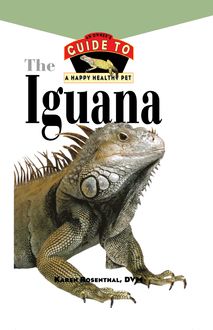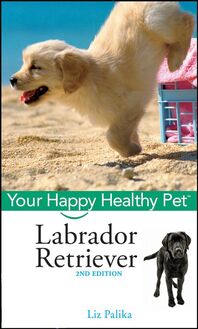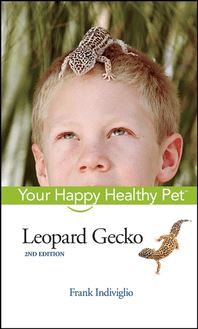Frogs and Toads , livre ebook
119
pages
English
Ebooks
2008
Vous pourrez modifier la taille du texte de cet ouvrage
Obtenez un accès à la bibliothèque pour le consulter en ligne En savoir plus
Découvre YouScribe en t'inscrivant gratuitement
Découvre YouScribe en t'inscrivant gratuitement
119
pages
English
Ebooks
2008
Vous pourrez modifier la taille du texte de cet ouvrage
Obtenez un accès à la bibliothèque pour le consulter en ligne En savoir plus
Publié par
Date de parution
22 janvier 2008
Nombre de lectures
0
EAN13
9780470191477
Langue
English
Poids de l'ouvrage
3 Mo
Frogs and toads are perennial favorite pets. They include easy-to-care for breeds and intriguing, exotic varieties. For both first-time pet owners and life-long hobbyists, frogs and toads can make fascinating pets, but it is essential to learn how to care for them properly. With colorful photos, charts, and tables, this guide covers the basics, including:
*
Choosing your frog or toad
*
Creating and maintaining your pet's new habitat
*
Feeding and caring for your frog or toad
*
Keeping your pet healthy
You'll also learn about the varieties of frogs and toads, and about their existence in the wild.
Part I: All About Frogs and Toads.
Chapter 1: What Are Frogs and Toads?
So Many Frogs and Toads.
Classifying Frogs and Toads.
What’s the Difference Between a Frog and a Toad?
Chapter 2: Frog Anatomy.
Limbs and Locomotion.
Frog Senses.
Frog Skin.
Temperature Regulation.
Chapter 3: Choosing Your Frog or Toad.
Where to Get Your Frog or Toad.
Before You Bring Your Frog Home.
Choosing a Healthy Frog.
Wild Caught vs. Captive Bred.
Part II: Caring for Frogs and Toads.
Chapter 4: Housing Your Frog or Toad.
Terrariums for Land Dwellers.
Aquariums for Aquatic Frogs.
Aqua-Terrariums for Semiaquatic Frogs.
Like Water for Frogs.
Water Essentials.
Temperature Control.
Chapter 5: Feeding Your Frog or Toad.
Insects.
How Much Food?
Feeding Tadpoles.
Chapter 6: Keeping Your Frog or Toad Healthy.
Life Span in Captivity.
Choosing a Veterinarian.
The Best Way to Avoid Problems.
Infectious Microbial Diseases.
Nutritional Disorders.
Chemical Intoxication.
Traumatic Injuries.
Handling Frogs and Toads.
Froggy Dangers to People.
Part III: Frogs and Toads in Our World.
Chapter 7: The Variety of Frogs and Toads.
Disc or Flat-Tongued Frogs.
Tailed Frogs.
True Toads.
Dart-Poison Frogs.
Poison Frogs as Pets.
Glass Frogs.
Tree Frogs.
Tropical Frogs.
Narrow-Mouthed Toads.
Spadefoot Toads.
Surinam Toads and African Clawed Frogs.
True Frogs.
Chapter 8: Frogs and Toads in the Wild.
Size and Growth.
Reproduction in Frogs and Toads.
Frog Communication.
Hibernation and Aestivation.
Releasing Frogs and Toads into the Wild.
Frogs, Toads, and the Law.
Protecting Frogs and Toads.
Appendix: Learning More About Your Frog or Toad.
Some Good Books.
Magazines.
Internet Resources.
Reptile and Amphibian Veterinarians.
Shows, Expos, and Swap Meets.
Shopping on the Internet.
Index.
Publié par
Date de parution
22 janvier 2008
Nombre de lectures
0
EAN13
9780470191477
Langue
English
Poids de l'ouvrage
3 Mo
This book is printed on acid-free paper.
Copyright © 2008 by Wiley Publishing, Inc., Hoboken, New Jersey. All rights reserved.
Howell Book House
Published by Wiley Publishing, Inc., Hoboken, New Jersey
No part of this publication may be reproduced, stored in a retrieval system or transmitted in any form or by any means, electronic, mechanical, photocopying, recording, scanning or otherwise, except as permitted under Sections 107 or 108 of the 1976 United States Copyright Act, without either the prior written permission of the Publisher, or authorization through payment of the appropriate per-copy fee to the Copyright Clearance Center, 222 Rosewood Drive, Danvers, MA 01923, (978) 750-8400, fax (978) 646-8600, or on the web at www.copyright.com . Requests to the Publisher for permission should be addressed to the Legal Department, Wiley Publishing, Inc., 10475 Crosspoint Blvd., Indianapolis, IN 46256, (317) 572-3447, fax (317) 572-4355, or online at http://www.wiley.com/go/permissions .
Wiley, the Wiley logo, Howell Book House, the Howell Book House logo, Your Happy Healthy Pet, and related trade dress are trademarks or registered trademarks of John Wiley & Sons, Inc. and/or its affiliates in the United States and other countries, and may not be used without written permission. All other trademarks are the property of their respective owners. Wiley Publishing, Inc. is not associated with any product or vendor mentioned in this book.
The publisher and the author make no representations or warranties with respect to the accuracy or completeness of the contents of this work and specifically disclaim all warranties, including without limitation warranties of fitness for a particular purpose. No warranty may be created or extended by sales or promotional materials. The advice and strategies contained herein may not be suitable for every situation. This work is sold with the understanding that the publisher is not engaged in rendering legal, accounting, or other professional services. If professional assistance is required, the services of a competent professional person should be sought. Neither the publisher nor the author shall be liable for damages arising here from. The fact that an organization or Website is referred to in this work as a citation and/or a potential source of further information does not mean that the author or the publisher endorses the information the organization or Website may provide or recommendations it may make. Further, readers should be aware that Internet Websites listed in this work may have changed or disappeared between when this work was written and when it is read.
For general information on our other products and services or to obtain technical support please contact our Customer Care Department within the U.S. at (800) 762-2974, outside the U.S. at (317) 572-3993 or fax (317) 572-4002.
Library of Congress Cataloging-in-Publication Data:
Grenard, Steve.
Frogs and toads / Steve Grenard. — 2nd ed.
p. cm. — (Your happy healthy pet)
ISBN 978-0-470-16510-2 (cloth : alk. paper)
1. Frogs as pets. 2. Toads as pets. 3. Frogs. 4. Toads. I. Title.
SF459.F83G74 2007
639.3’789—dc22
2007018915
Printed in the United States of America
10 9 8 7 6 5 4 3 2 1
2nd Edition
Illustration on page 112 by Brooke Graczyk
Book design by Melissa Auciello-Brogan
Cover design by Michael J. Freeland
Book production by Wiley Publishing, Inc. Composition Services
Wiley Bicentennial Logo: Richard J. Pacifico
About the Author
Steve Grenard is an avid herpetologist with more than forty years of experience with amphibians and reptiles; he published a paper on the reproduction of the Marsupial Frog in 1958. In the summer of 2000, he published a controversial and widely debated review in Natural History Magazine on the possibility of American rattlesnake venoms evolving new properties. He is the author of several Howell Book House titles, including: Your Happy Healthy Pet: Bearded Dragon, An Owner’s Guide to a Happy Healthy Pet: The Lizard , and Amphibians: Their Care and Keeping . He is also the author of a number of scholarly medical and herpetological books, including Medical Herpetology and Handbook of Alligators and Crocodiles , and is the author of Introduction to Respiratory Care , a best-selling text review of respiratory therapy. Steve is a board-certified respiratory therapist and polysomnographer and is the clinical coordinator of the Institute of Sleep Medicine at Staten Island University Hospital in Staten Island, New York.
About Howell Book House
Since 1961, Howell Book House has been America’s premier publisher of pet books. We’re dedicated to companion animals and the people who love them, and our books reflect that commitment. Our stable of authors—training experts, veterinarians, breeders, and other authorities—is second to none. And we’ve won more Maxwell Awards from the Dog Writers Association of America than any other publisher.
As we head toward the half-century mark, we’re more committed than ever to providing new and innovative books, along with the classics our readers have grown to love. From bringing home a new puppy to competing in advanced equestrian events, Howell has the titles that keep animal lovers coming back again and again.
Contents
Part I: All About Frogs and Toads
Chapter 1: What Are Frogs and Toads?
So Many Frogs and Toads
Classifying Frogs and Toads
What’s the Difference Between a Frog and a Toad?
Chapter 2: Frog Anatomy
Limbs and Locomotion
Frog Senses
Frog Skin
Temperature Regulation
Chapter 3: Choosing Your Frog or Toad
Where to Get Your Frog or Toad
Before You Bring Your Frog Home
Choosing a Healthy Frog
Wild Caught vs. Captive Bred
Part II: Caring for Frogs and Toads
Chapter 4: Housing Your Frog or Toad
Terrariums for Land Dwellers
Aquariums for Aquatic Frogs
Aqua-Terrariums for Semiaquatic Frogs
Like Water for Frogs
Water Essentials
Temperature Control
Chapter 5: Feeding Your Frog or Toad
Insects
How Much Food?
Feeding Tadpoles
Chapter 6: Keeping Your Frog or Toad Healthy
Life Span in Captivity
Choosing a Veterinarian
The Best Way to Avoid Problems
Infectious Microbial Diseases
Nutritional Disorders
Chemical Intoxication
Traumatic Injuries
Handling Frogs and Toads
Froggy Dangers to People
Part III: Frogs and Toads in Our World
Chapter 7: The Variety of Frogs and Toads
Disc or Flat-Tongued Frogs
Tailed Frogs
True Toads
Dart-Poison Frogs
Poison Frogs as Pets
Glass Frogs
Tree Frogs
Tropical Frogs
Narrow-Mouthed Toads
Spadefoot Toads
Surinam Toads and African Clawed Frogs
True Frogs
Chapter 8: Frogs and Toads in the Wild
Size and Growth
Reproduction in Frogs and Toads
Frog Communication
Hibernation and Aestivation
Releasing Frogs and Toads into the Wild
Frogs, Toads, and the Law
Protecting Frogs and Toads
Appendix: Learning More About Your Frog or Toad
Some Good Books
Magazines
Internet Resources
Reptile and Amphibian Veterinarians
Shows, Expos, and Swap Meets
Shopping on the Internet
Index
A Typical Frog
Chapter 1
What Are Frogs and Toads?
F rogs and toads are four-legged, tailless, air-breathing vertebrates that represent the link between the fish and reptiles and all other air-breathing species, including humans. They are members of a class or group of vertebrates known as the Amphibia , a word that means “dual life” and refers to the fact that amphibian life occurs in two phases—one in the water and the other on land. It also alludes to the fact that many amphibians are, well, amphibious, and are as fully at home in the water as they are on land (although there are many notable exceptions, including species that never leave the water and others that stay on land or in trees and never enter the water at all).
The first amphibians, the labryinthodonts, took the great leap from water to land during the Devonian period some 400 million years ago. However, fossils of frogs appear much later, in the Jurassic period of North America, some 280 million years ago.
The other amphibian groups or orders include the Caudates or Urodeles, which are known familiarly as salamanders and newts, and an obscure order known as the Apoda (legless amphibians), or caecilians. These segmented, wormlike creatures are found primarily in tropical regions and remain burrowed in moist soil most of the time. Little is known of their habits or life history.
Clearly, of all the amphibians, frogs and toads are the most familiar and best studied. Frogs and toads are members of the order Anura , a term that means “tailless,” which is exactly what they are—bereft of a true tail, unlike their salamander cousins.
At the basic level, frogs and toads are tailless amphibians .
So Many Frogs and Toads
There are more than an estimated 5,200 species and subspecies of frogs and toads in the world, but nobody knows exactly how many there really are because new species and subspecies are being discovered by scientists at the rate of more than a dozen a year. Amazingly, it is predicted that such discoveries may go on indefinitely, as long as the precious habitats of these animals is protected from destruction. Environmental insults and habitat destruction have already caused the extinction of countless species over the last few decades; it is theorized that some rare species became extinct before scientists learned of their existence. Since 1980, at least 120 species of amphibians are believed to have become extinct, although there may be many more.
The number of different species of frogs and toads increases as the climate gets warmer, and the neotropical and tropical regions of the world tend to have more species than the temperate, and therefore colder, climates. In one small valley (San Cecilia) in Ecuador’s Amazon basin, scientists discovered a total of eighty-one species of frogs and toads, finding fifty-six in














